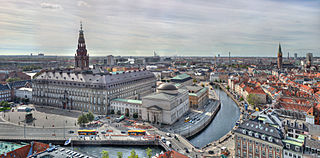
Copenhagen is the capital and most populous city of Denmark, with a population of around 660,000 in the municipality and 1.4 million in the urban area. The city is on the islands of Zealand and Amager, separated from Malmö, Sweden, by the Øresund strait. The Øresund Bridge connects the two cities by rail and road.
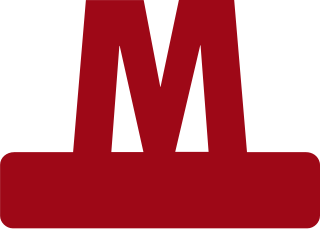
The Copenhagen Metro is a 24/7 light rapid transit system in Copenhagen, Denmark, serving the municipalities of Copenhagen, Frederiksberg, and Tårnby.
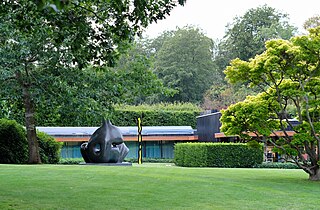
The Louisiana Museum of Modern Art, also known as just Louisiana is an art museum located on the shore of the Øresund Sound in Humlebæk, 35 km (22 mi) north of Copenhagen, Denmark. It is the most visited art museum in Denmark, and has an extensive permanent collection of modern and contemporary art, dating from World War II to the present day; in addition, it has a comprehensive programme of special exhibitions. The museum is also acknowledged as a milestone in modern Danish architecture, and is noted for its synthesis of art, architecture, and landscape, such as was showcased in an installation entitled "Riverbed" shown in 2014–2015. It has been called a "Danish beacon in the international art world." The museum occasionally also stages exhibitions of work by the great impressionists and expressionists, such as Claude Monet, who was the focus of a major exhibition in 1994. It has between 600,000–700,000 visitors per year, 17–33% of whom reside in nearby Sweden.

Frederiksberg Gardens is one of the largest and most attractive greenspaces in Copenhagen, Denmark. Together with the adjacent Søndermarken it forms a green area of 64 hectares at the western edge of Inner Copenhagen. It is a romantic landscape garden designed in the English style.

The City Circle Line or M3 is a loop line of the Copenhagen Metro. It has been claimed by COWI A/S that the City Circle Line is the largest construction project to have taken place in Copenhagen during the last 400 years. The network's total length is 15.5 kilometres (9.6 mi) and has 17 stations. The line opened on 29 September 2019.

Ordrupgaard is a state-owned art museum situated near Jægersborg Dyrehave, north of Copenhagen, Denmark. The museum houses one of Northern Europe's most important collections of Danish and French art from the 19th and beginning of the 20th century.

Søndermarken is a park in Frederiksberg on the border to Valby and the Carlsberg area in Copenhagen, Denmark. It shares much of its history with Frederiksberg Gardens from which it is separated only by Roskildevej. Cisternerne—an underground venue for art exhibitions in the former cisterns—are located inside the park.
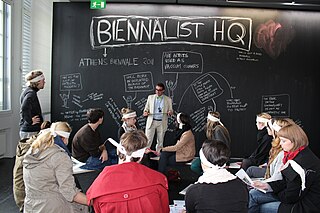
Thierry Geoffroy, also known as Colonel, is a Danish-French artist, living in Copenhagen, Denmark. He is a Conceptual artist using a wide variety of media including video and installations, often collaborative with other artists.

Frederiksberg is a part of the Capital Region of Denmark. It is formally an independent municipality, Frederiksberg Municipality, separate from Copenhagen Municipality, but both are a part of the City of Copenhagen. It occupies an area of less than 9 km2 and had a population of 103,192 in 2015.

Carlsberg, is an area located straddling the border of Valby and Vesterbro districts in central Copenhagen, Denmark approximately 2.4 km from the City Hall Square. The area emerged when J.C. Jacobsen founded his original brewery in the district in 1847. The first brewing took place on 11 November 1847 and production continued until 30 October 2008, when production was moved to Fredericia in Jutland. The Jacobsen House Brewery is however still located in the district and produces specialty beers. The entire brewery grounds spread over more than 30 hectares and is currently being transformed into a new city district in Copenhagen.
Astrid Kruse Jensen is a Danish photographer and visual artist. She studied at the Gerrit Rietveld Academie in the Netherlands and the Glasgow School of Art in Scotland. Her artistic work is often characterized by its dreamy qualities, blurring the boundaries between memory, consciousness, reality, and illusion.

Frederiksberg Runddel is a space in front of the main entrance to Frederiksberg Gardens, at the end of Frederiksberg Allé, in the Frederiksberg district of Copenhagen, Denmark.

Jørgen Haugen Sørensen was one of Denmark's most eminent sculptors. He had his artistic debut at the acclaimed and prestigious Spring Exhibition (Forårsudstillingen) at Kunsthal Charlottenborg, Copenhagen in 1953. Haugen Sørensen was a member of the artistic union Decembristerne and the artist collective Grønningen, as well as Veksølund in Denmark.
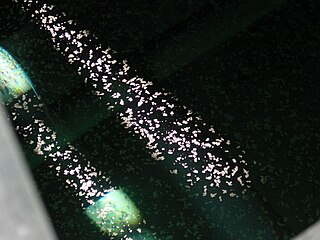
Calcite crystals form on the surface of quiescent bodies of water, even when the bulk water is not supersaturated with respect to calcium carbonate. The crystals grow, attach to one other and appear to be floating rafts of a white, opaque material. The floating materials have been referred to as calcite rafts or "leopard spots".

Søndre and Nordre Fasanvej are two streets that form a long south-to-north artery through Frederiksberg, an independent municipality surrounded by the larger Copenhagen Municipality in Copenhagen, Denmark. The southern part of the street is surrounded by large green spaces and attractive residential neighborhoods, and its northern part, which enters the Nørrebro and North-West districts of Copenhagen, is dominated by former industrial sites. The street takes its name after Fasangården, a former royal pheasantry, in Frederiksberg Park.
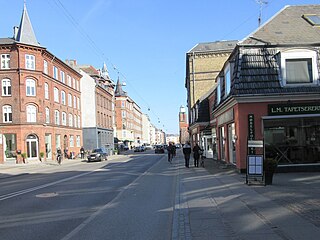
Smallegade is a busy shopping street in the central part of Frederiksberg in Copenhagen, Denmark. It runs from the Town Hall Square in the east to Fasanvej in the west, along the north side of Frederiksberg Town Hall and Frederiksberg Park, linking Gammel Kongevej with Peter Bangs Vej. On the other side of the Town Hall is Bredegade, now smaller than Smallegade, which after a while joins Smallegade at Møstings Hus, an 18th-century country house-turned-exhibitions space, which overlooks a small pond.

Copenhagen Waterworks opened in 1859 in Copenhagen, Denmark. Located in Studiestræde, between Axeltorv and H. C. Andersens Boulevard, it was Denmark's first waterworks and continued operations until 1951. The complex was designated an Industrial Heritage Site in 2007 and listed in 2010. The former engine house is now home to concert venue Pumpehuset. The other buildings house a daycare.

Møstings Hus is a small Neoclassical country house now used as an exhibition space in the Frederiksberg district of Copenhagen, Denmark. A pond lies in front of the building.
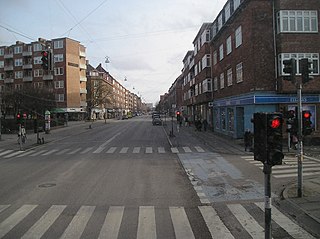
Peter Bangs Vej is a 2.2 km long street in Frederiksberg, a city in the Copenhagen area on the island of Zealand, Denmark. The direct continuation of Smallegade, it initially runs west, from Nordre Fasanvej, but then turns south along the east side of Damhus Lake to meet Roskildevej. There is a large sports complex on the south end of the street with the football club F.C. Copenhagen's training facilities as well as the multi-purpose venue K.B. Hallen.

The Cave of Hercules is a subterranean vaulted space dating back to Roman times located in the alley of San Ginés in the city of Toledo, Spain. The cave is under a building located where the Church of San Ginés, Toledo stood until 1841.

























